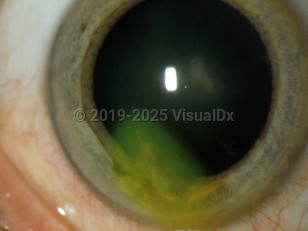Emergency: requires immediate attention
Ruptured globe - External and Internal Eye
Alerts and Notices
Important News & Links
Synopsis

A ruptured globe is the descriptive term of any full-thickness defect in the cornea and/or sclera. The vast majority of ruptured globes are as a result of traumatic injuries, either penetrating or perforating types. Through and through, perforating injuries are most often far more dangerous. There are, however, disease entities that can result in a ruptured globe even though the frequency of such is very low. Signs and symptoms of a ruptured globe depend upon the location and the profoundness of the injury. Patients can present with almost normal vision and minimal apparent injury and yet still have a ruptured globe. Usually there is clear-cut evidence of severe injury with major vision-limiting effects. Tearing, pain, anatomical distortion, vision blurring or loss, frank bleeding, diplopia, presence of pigmented tissue extruding from the wound, or a history of disease entities that can cause a globe rupture are the usual presenting signs and symptoms of a globe rupture.
Codes
ICD10CM:
S05.90XA – Unspecified injury of unspecified eye and orbit, initial encounter
SNOMEDCT:
231791008 – Rupture of globe
S05.90XA – Unspecified injury of unspecified eye and orbit, initial encounter
SNOMEDCT:
231791008 – Rupture of globe
Look For
Subscription Required
Diagnostic Pearls
Subscription Required
Differential Diagnosis & Pitfalls

To perform a comparison, select diagnoses from the classic differential
Subscription Required
Best Tests
Subscription Required
Management Pearls
Subscription Required
Therapy
Subscription Required
References
Subscription Required
Last Updated:07/24/2007
Emergency: requires immediate attention
Ruptured globe - External and Internal Eye

